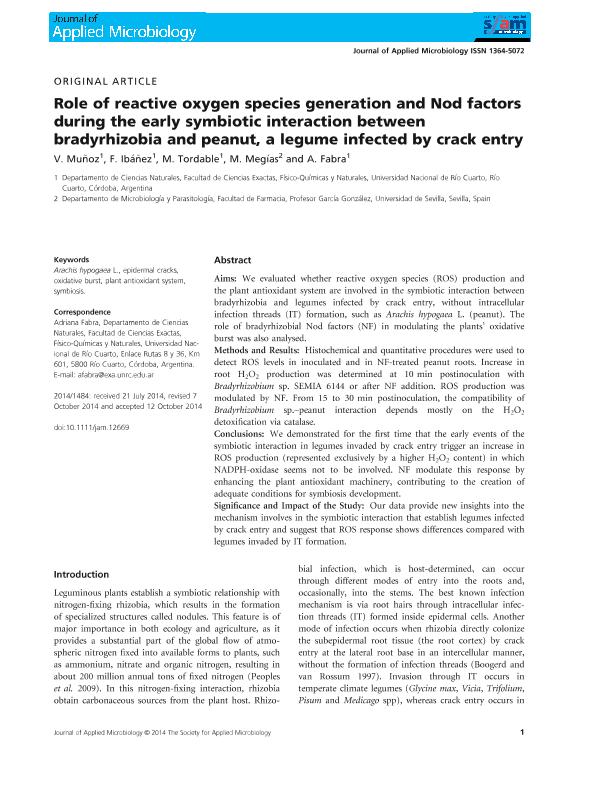Mostrar el registro sencillo del ítem
dc.contributor.author
Muñoz, Vanina Laura

dc.contributor.author
Ibañez, Fernando Julio

dc.contributor.author
Tordable, Maria del Carmen

dc.contributor.author
Megías, M.
dc.contributor.author
Fabra, Adriana Isidora

dc.date.available
2018-01-29T21:50:21Z
dc.date.issued
2014-11
dc.identifier.citation
Muñoz, Vanina Laura; Ibañez, Fernando Julio; Tordable, Maria del Carmen; Megías, M.; Fabra, Adriana Isidora; Role of reactive oxygen species generation and Nod factors during the early symbiotic interaction between bradyrhizobia and peanut, a legume infected by crack entry; Wiley; Journal of Applied Microbiology; 118; 1; 11-2014; 182-192
dc.identifier.issn
1364-5072
dc.identifier.uri
http://hdl.handle.net/11336/34965
dc.description.abstract
Aims: We evaluated whether reactive oxygen species (ROS) production and the plant antioxidant system are involved in the symbiotic interaction between bradyrhizobia and legumes infected by crack entry, without intracellular infection threads (IT) formation, such as Arachis hypogaea L. (peanut). The role of bradyrhizobial Nod factors (NF) in modulating the plants’ oxidative burst was also analysed. Methods and Results: Histochemical and quantitative procedures were used to detect ROS levels in inoculated and in NF-treated peanut roots. Increase in root H2O2 production was determined at 10 min postinoculation with Bradyrhizobium sp. SEMIA 6144 or after NF addition. ROS production was modulated by NF. From 15 to 30 min postinoculation, the compatibility of Bradyrhizobium sp.–peanut interaction depends mostly on the H2O2 detoxification via catalase. Conclusions: We demonstrated for the first time that the early events of the symbiotic interaction in legumes invaded by crack entry trigger an increase in ROS production (represented exclusively by a higher H2O2 content) in which NADPH-oxidase seems not to be involved. NF modulate this response by enhancing the plant antioxidant machinery, contributing to the creation of adequate conditions for symbiosis development. Significance and Impact of the Study: Our data provide new insights into the mechanism involves in the symbiotic interaction that establish legumes infected by crack entry and suggest that ROS response shows differences compared with legumes invaded by IT formation.
dc.format
application/pdf
dc.language.iso
eng
dc.publisher
Wiley

dc.rights
info:eu-repo/semantics/openAccess
dc.rights.uri
https://creativecommons.org/licenses/by-nc-sa/2.5/ar/
dc.subject
Arachis Hypogaea
dc.subject
Epidermal Crack
dc.subject
Oxidative Burst
dc.subject
Plant Antioxidant System
dc.subject
Symbiosis
dc.subject.classification
Otras Ciencias Biológicas

dc.subject.classification
Ciencias Biológicas

dc.subject.classification
CIENCIAS NATURALES Y EXACTAS

dc.title
Role of reactive oxygen species generation and Nod factors during the early symbiotic interaction between bradyrhizobia and peanut, a legume infected by crack entry
dc.type
info:eu-repo/semantics/article
dc.type
info:ar-repo/semantics/artículo
dc.type
info:eu-repo/semantics/publishedVersion
dc.date.updated
2018-01-29T19:45:55Z
dc.journal.volume
118
dc.journal.number
1
dc.journal.pagination
182-192
dc.journal.pais
Estados Unidos

dc.journal.ciudad
Hoboken
dc.description.fil
Fil: Muñoz, Vanina Laura. Universidad Nacional de Río Cuarto. Facultad de Ciencias Exactas Fisicoquímicas y Naturales; Argentina. Consejo Nacional de Investigaciones Científicas y Técnicas; Argentina
dc.description.fil
Fil: Ibañez, Fernando Julio. Universidad Nacional de Río Cuarto. Facultad de Ciencias Exactas Fisicoquímicas y Naturales; Argentina. Consejo Nacional de Investigaciones Científicas y Técnicas; Argentina
dc.description.fil
Fil: Tordable, Maria del Carmen. Universidad Nacional de Río Cuarto. Facultad de Ciencias Exactas Fisicoquímicas y Naturales; Argentina
dc.description.fil
Fil: Megías, M.. Universidad de Sevilla; España
dc.description.fil
Fil: Fabra, Adriana Isidora. Universidad Nacional de Río Cuarto. Facultad de Ciencias Exactas Fisicoquímicas y Naturales; Argentina. Consejo Nacional de Investigaciones Científicas y Técnicas; Argentina
dc.journal.title
Journal of Applied Microbiology

dc.relation.alternativeid
info:eu-repo/semantics/altIdentifier/doi/http://dx.doi.org/10.1111/jam.12669
dc.relation.alternativeid
info:eu-repo/semantics/altIdentifier/url/http://onlinelibrary.wiley.com/doi/10.1111/jam.12669/abstract
Archivos asociados
